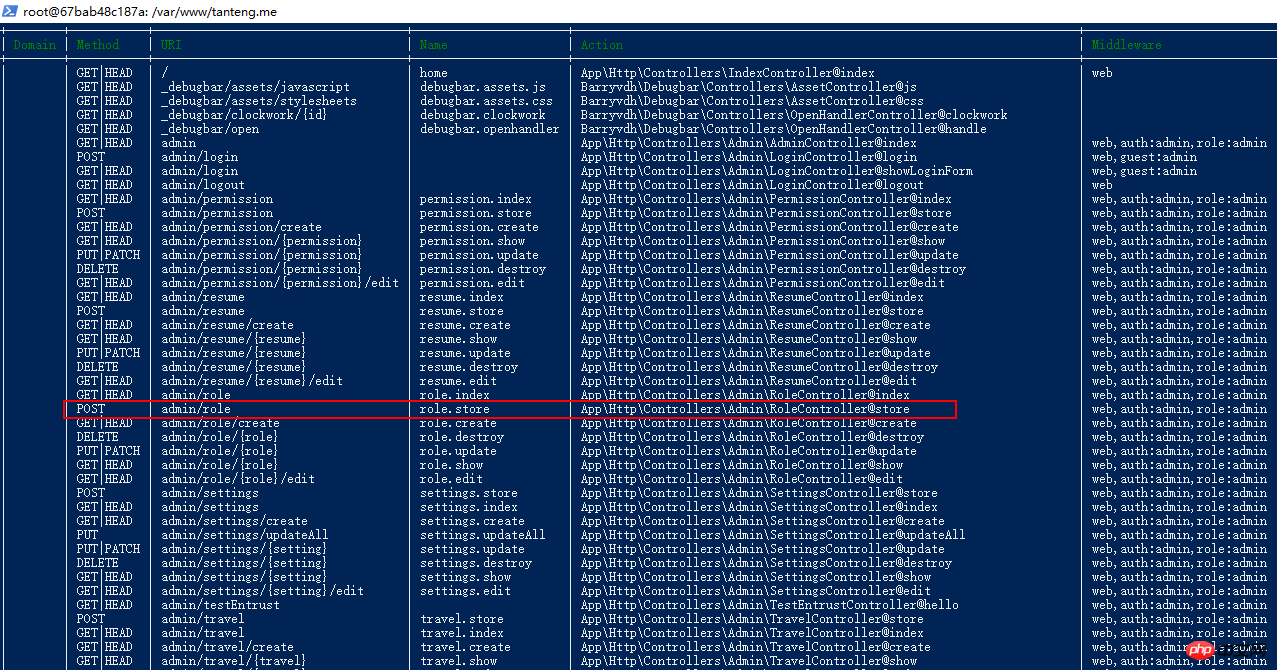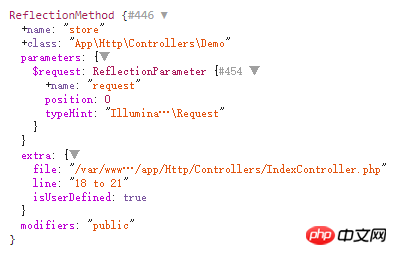 Backend Development
Backend Development
 PHP Tutorial
PHP Tutorial
 Detailed explanation of source code analysis and Laravel dependency injection steps
Detailed explanation of source code analysis and Laravel dependency injection steps
Detailed explanation of source code analysis and Laravel dependency injection steps
This time I will bring you source code analysis LaravelDependency injectiondetailed steps, source code analysis Laravel dependency injectionWhat are the precautions, the following is a practical case, let's take a look.
Preface
As we all know, there are countless PHP frameworks. In recent years, a framework known for its elegance has gradually been known by domestic PHPers. , and started using it, but one obvious shortcoming of larave is that its documentation content is pitiful.
This article will give you a detailed introduction to Laravel dependency injection and share it for your reference and study. I won’t say much below, let’s take a look at the detailed introduction.
In Laravel's controller's constructor method or member method, you can use dependency injection through type constraints , such as:
public function store(Request $request)
{
//TODO
}Here, the $request parameter uses type constraints. Request is a class:\Illuminate\Http\Request, which means that the parameter must be this class or a subclass.
This article analyzes the source code of Laravel to see why Request can be used directly without passing in an instance in the method? It’s just that the framework automatically instantiates and passes parameters for us.
1. Route definition
Looking from the source, such a route is defined in the route definition file:
Route::resource('/role', 'Admin\RoleController');This is a resource-based route. Laravel will automatically generate routing entries for additions, deletions, modifications and queries.

The store method at the beginning of this article is a controller method. The Action defined by the route visible in the figure is also: App\Http\Controllers\Admin\RoleController@store
Routing method analysis
Find the controller and method according to the routing definition, and execute the specific method in the dispatch method.
(File: vendor/laravel/framework/src/Illuminate/Routing/ControllerDispatcher.php)
public function dispatch(Route $route, $controller, $method)
{
$parameters = $this->resolveClassMethodDependencies(
$route->parametersWithoutNulls(), $controller, $method
);
if (method_exists($controller, 'callAction')) {
return $controller->callAction($method, $parameters);
}
return $controller->{$method}(...array_values($parameters));
}First resolveClassMethodDependencies method, "as the name suggests" is to obtain dependent objects based on the method parameters of the class, and then Then call the class method and inject the object parameters.
If there are multiple dependent objects, they will be parsed out by foreach in turn and injected as parameters.
Get the code for the dependent object example:
protected function resolveClassMethodDependencies(array $parameters, $instance, $method)
{
if (! method_exists($instance, $method)) {
return $parameters;
}
return $this->resolveMethodDependencies(
$parameters, new ReflectionMethod($instance, $method)
);
}The key point here is the use of PHP reflection. Pay attention to the RelectionMethod method. It obtains the method parameter list of the class and can know the type constraints of the parameters. name etc.
The $instance parameter here is the RoleController controller class, and the $method parameter is the method name store.
2. Example of obtaining dependent objects
After obtaining the constraint type of the dependent object from the method parameters, you can instantiate the dependent object.
protected function transformDependency(ReflectionParameter $parameter, $parameters)
{
$class = $parameter->getClass();
// If the parameter has a type-hinted class, we will check to see if it is already in
// the list of parameters. If it is we will just skip it as it is probably a model
// binding and we do not want to mess with those; otherwise, we resolve it here.
if ($class && ! $this->alreadyInParameters($class->name, $parameters)) {
return $parameter->isDefaultValueAvailable()
? $parameter->getDefaultValue()
: $this->container->make($class->name);
}
}Get the object from the container based on the class name. The process of binding the object instance is first defined in the service provider.
Then pass the instantiated object into the store method, and you can use the dependent object.
3. About PHP reflection
Give an example of using ReflectionMethod.
class Demo
{
private $request;
public function store(Request $request)
{
}
}Print out the content of new ReflectionMethod(Demo::class, 'store') as shown in the figure:

php data structure and sequential linked list, detailed explanation of the use of linked linear list
php implements statistical binary Detailed explanation of the steps of the number of 1 algorithm
The above is the detailed content of Detailed explanation of source code analysis and Laravel dependency injection steps. For more information, please follow other related articles on the PHP Chinese website!

Hot AI Tools

Undresser.AI Undress
AI-powered app for creating realistic nude photos

AI Clothes Remover
Online AI tool for removing clothes from photos.

Undress AI Tool
Undress images for free

Clothoff.io
AI clothes remover

Video Face Swap
Swap faces in any video effortlessly with our completely free AI face swap tool!

Hot Article

Hot Tools

Notepad++7.3.1
Easy-to-use and free code editor

SublimeText3 Chinese version
Chinese version, very easy to use

Zend Studio 13.0.1
Powerful PHP integrated development environment

Dreamweaver CS6
Visual web development tools

SublimeText3 Mac version
God-level code editing software (SublimeText3)

Hot Topics
 Laravel Eloquent ORM in Bangla partial model search)
Apr 08, 2025 pm 02:06 PM
Laravel Eloquent ORM in Bangla partial model search)
Apr 08, 2025 pm 02:06 PM
LaravelEloquent Model Retrieval: Easily obtaining database data EloquentORM provides a concise and easy-to-understand way to operate the database. This article will introduce various Eloquent model search techniques in detail to help you obtain data from the database efficiently. 1. Get all records. Use the all() method to get all records in the database table: useApp\Models\Post;$posts=Post::all(); This will return a collection. You can access data using foreach loop or other collection methods: foreach($postsas$post){echo$post->
 Laravel Introduction Example
Apr 18, 2025 pm 12:45 PM
Laravel Introduction Example
Apr 18, 2025 pm 12:45 PM
Laravel is a PHP framework for easy building of web applications. It provides a range of powerful features including: Installation: Install the Laravel CLI globally with Composer and create applications in the project directory. Routing: Define the relationship between the URL and the handler in routes/web.php. View: Create a view in resources/views to render the application's interface. Database Integration: Provides out-of-the-box integration with databases such as MySQL and uses migration to create and modify tables. Model and Controller: The model represents the database entity and the controller processes HTTP requests.
 Solve caching issues in Craft CMS: Using wiejeben/craft-laravel-mix plug-in
Apr 18, 2025 am 09:24 AM
Solve caching issues in Craft CMS: Using wiejeben/craft-laravel-mix plug-in
Apr 18, 2025 am 09:24 AM
When developing websites using CraftCMS, you often encounter resource file caching problems, especially when you frequently update CSS and JavaScript files, old versions of files may still be cached by the browser, causing users to not see the latest changes in time. This problem not only affects the user experience, but also increases the difficulty of development and debugging. Recently, I encountered similar troubles in my project, and after some exploration, I found the plugin wiejeben/craft-laravel-mix, which perfectly solved my caching problem.
 Laravel user login function
Apr 18, 2025 pm 12:48 PM
Laravel user login function
Apr 18, 2025 pm 12:48 PM
Laravel provides a comprehensive Auth framework for implementing user login functions, including: Defining user models (Eloquent model), creating login forms (Blade template engine), writing login controllers (inheriting Auth\LoginController), verifying login requests (Auth::attempt) Redirecting after login is successful (redirect) considering security factors: hash passwords, anti-CSRF protection, rate limiting and security headers. In addition, the Auth framework also provides functions such as resetting passwords, registering and verifying emails. For details, please refer to the Laravel documentation: https://laravel.com/doc
 Laravel's geospatial: Optimization of interactive maps and large amounts of data
Apr 08, 2025 pm 12:24 PM
Laravel's geospatial: Optimization of interactive maps and large amounts of data
Apr 08, 2025 pm 12:24 PM
Efficiently process 7 million records and create interactive maps with geospatial technology. This article explores how to efficiently process over 7 million records using Laravel and MySQL and convert them into interactive map visualizations. Initial challenge project requirements: Extract valuable insights using 7 million records in MySQL database. Many people first consider programming languages, but ignore the database itself: Can it meet the needs? Is data migration or structural adjustment required? Can MySQL withstand such a large data load? Preliminary analysis: Key filters and properties need to be identified. After analysis, it was found that only a few attributes were related to the solution. We verified the feasibility of the filter and set some restrictions to optimize the search. Map search based on city
 Laravel and the Backend: Powering Web Application Logic
Apr 11, 2025 am 11:29 AM
Laravel and the Backend: Powering Web Application Logic
Apr 11, 2025 am 11:29 AM
How does Laravel play a role in backend logic? It simplifies and enhances backend development through routing systems, EloquentORM, authentication and authorization, event and listeners, and performance optimization. 1. The routing system allows the definition of URL structure and request processing logic. 2.EloquentORM simplifies database interaction. 3. The authentication and authorization system is convenient for user management. 4. The event and listener implement loosely coupled code structure. 5. Performance optimization improves application efficiency through caching and queueing.
 Laravel framework installation method
Apr 18, 2025 pm 12:54 PM
Laravel framework installation method
Apr 18, 2025 pm 12:54 PM
Article summary: This article provides detailed step-by-step instructions to guide readers on how to easily install the Laravel framework. Laravel is a powerful PHP framework that speeds up the development process of web applications. This tutorial covers the installation process from system requirements to configuring databases and setting up routing. By following these steps, readers can quickly and efficiently lay a solid foundation for their Laravel project.
 How to view the version number of laravel? How to view the version number of laravel
Apr 18, 2025 pm 01:00 PM
How to view the version number of laravel? How to view the version number of laravel
Apr 18, 2025 pm 01:00 PM
The Laravel framework has built-in methods to easily view its version number to meet the different needs of developers. This article will explore these methods, including using the Composer command line tool, accessing .env files, or obtaining version information through PHP code. These methods are essential for maintaining and managing versioning of Laravel applications.





